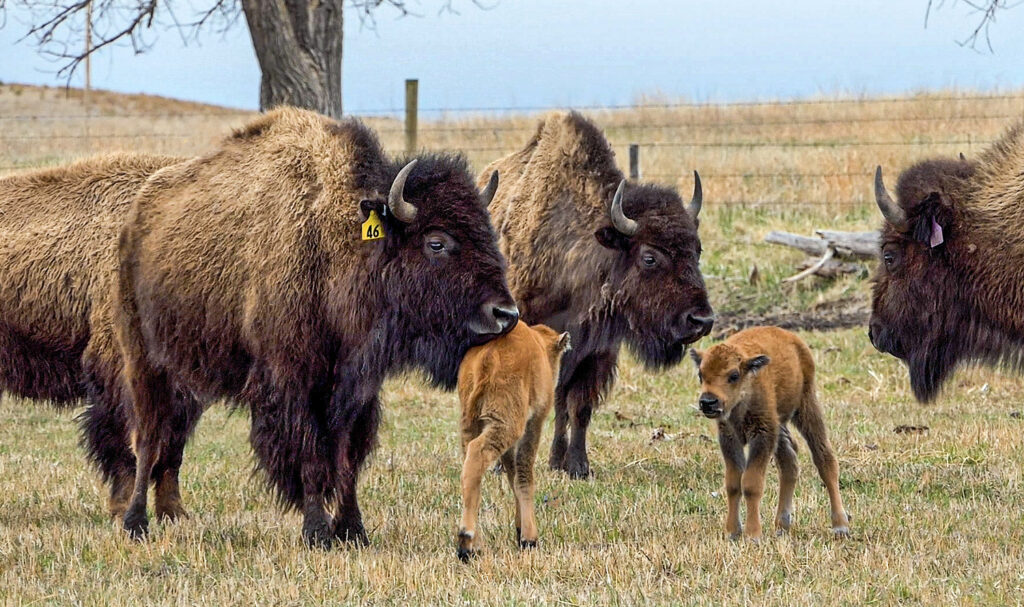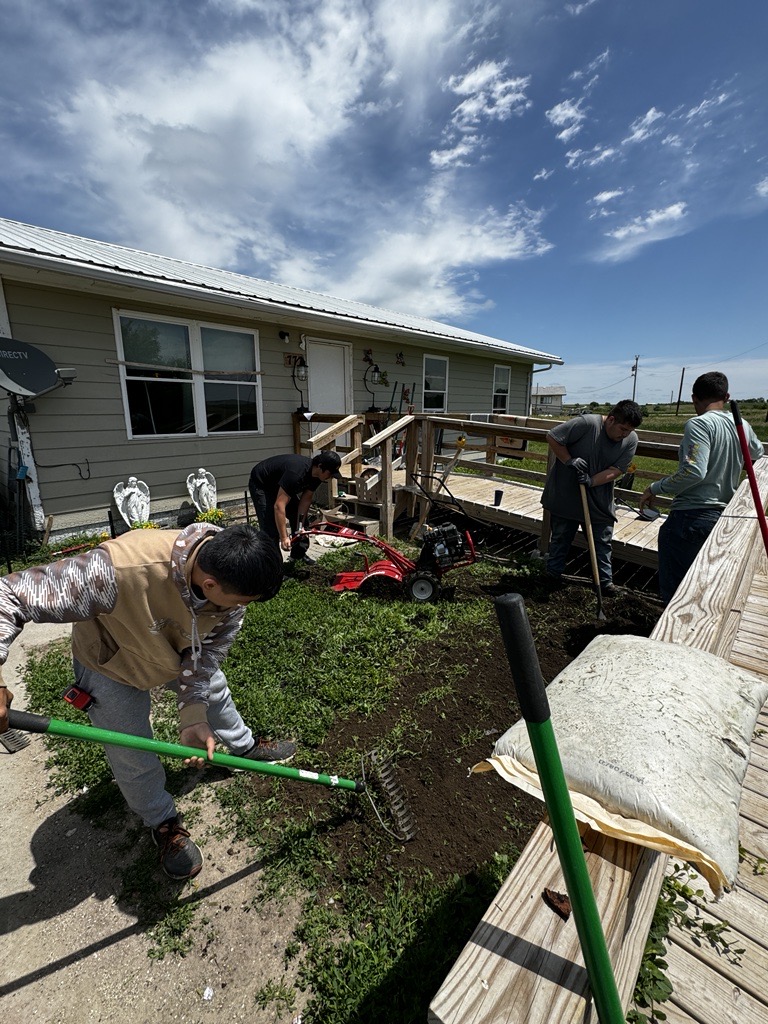The monumental Gila River Indian Community Water Rights Settlement celebrates its 21st anniversary
Sicangu Lakota citizens grow vision for future of food
‘It really humbled me, being able to be in the garden’

Chickens at Keya Wakpala Gardens (Photo courtesy by Sicangu Co employees).
At the height of South Dakota’s growing season, you can find Siċaŋġu Lak̇ota youth busy at Keya Wakpala Gardens. They feed the chickens and gather eggs. Some harvest lettuce, rhubarb and cilantro. At a workshop, they preserve strawberry jam.
Five high school students are participating in this season’s Next Gen internship of the Siċaŋġu Food Sovereignty Initiative. At a one-acre community farm site just outside of Mission, on the Rosebud Indian Reservation, they are learning how to produce and prepare food.
The program aims to benefit their families and community. It is just one facet of the initiative from Siċaŋġu Co., “the economic engine” of the Siċaŋġu Lak̇ota Oyate nation. The tribally chartered non-profit community development corporation seeks to establish an environmentally conscious, self-sustaining economy by transforming the food system on the reservation.

“Our goal is to increase local food access and in order to do that we have to increase the number of local food producers,” said Matte Wilson, director of the Siċaŋġu Lak̇ota Food Sovereignty Initiative. He spoke on July 10 at one of several “Ask Us Anything” community forums.
The initiative is among 10 international winners of the 2019 Food System Vision Prize. It stems from Sicangu Co’s opening of Keya Wakpala Gardens in 2015. The gardens’ name means Turtle Creek, after a stream that runs alongside it. The teaching and production farm project offered an adult internship in 2017, before adding its program for high school students.
In mid-July, the interns participated in a buffalo harvest – a first for some. After praying and offering tobacco, they helped butcher. They packaged cuts of roasts and steaks, wasting nothing in honor of the “sacred bond” with the bison. The Siċaŋġu Lakota are among the tribes severed from buffalo foodways more than a century ago. However, today, through Siċaŋġu Co, the oyate maintain the world’s largest Native-owned bison herd.
“Our goal is to increase local food access and in order to do that we have to increase the number of local food producers.”
Matte Wilson, director of the Sicangu Food Sovereignty Initiative
Commercial buffalo hunting in the mid-1800s nearly wiped out the herds that constituted the Siċaŋġu Lak̇ota Oyate’s “physical, cultural, and spiritual source of sustenance.” United States assimilation policies enabled the boarding school system, which was among factors that “intentionally destroyed traditional foodways to cultivate dependence,” according to framers of the Sicangu Food Sovereignty Initiative.
Reconnecting to traditional self-sufficiency practices means “knowing you helped do everything and then you’re able to take it home and feed it to your family,” said Echo Clairmont, program manager at the Siċaŋġu Food Sovereignty Initiative. “What a feeling.”

Many of the 28,000 Rosebud residents are food insecure. Household income levels are among the lowest in the U.S. Fresh, nutritional store-bought items can be unaffordable, and transportation to any commercial source is challenging.
On the Rosebud Reservation, only three grocery stores serve an area larger than the state of Rhode Island. Public transit services are meager. Community members may drive upwards of 40 minutes to buy food. Sometimes, the store produce is wilted or spoiled, said reservation resident Mary Jane Bone Shirt, a citizen of the Rosebud Sioux Tribe.
In 2023, Bone Shirt was an intern at Siċaŋġu Co’s adult program Waičaȟya Ičaǧapi Kte, “They Will Grow into Producers.” She liked the program’s hands-on approach to garden education and its inspiring tours of different farms, she told Buffalo’s Fire.
Any Siċaŋġu Lakota citizen or community member living on the Rosebud Reservation can practice the technical skills of growing and distributing food through the programs’ paid internships. Food sovereignty can look as straightforward as “being able to have that freedom of going out into your backyard and being able to pick what you want,” Clairmont said.
However, the Sicangu Food Sovereignty Initiative recognizes that a food system intrinsically involves many social, economic and political elements. Community members are “side by side with each other,” Clairmont said. “Different generations, but still the same mind, the same change, [the] same want for your community and reservation.”
For some youth interns, the program is not only their first time growing vegetables but also their first job interview or work experience, she noted. “We’re preparing our youth for what’s next – giving them what we wish we had growing up.”
“[You have to] really be positive in [the gardens], because what you put into the plant is what you get back.”
Echo Clairmont, program manager at the Siċaŋġu Food Sovereignty Initiative
The program makes time for financial literacy discussions and a field trip to Western Dakota Technical College in Rapid City, South Dakota’s second-largest city.
Work in the gardens helps some address feelings of anxiety and depression, among other mental health conditions. “The garden is a safe place, it’s a place to learn and to grow. Not only with each other as humans but with the plants as well,” Clairmont said.
“It really humbled me, being able to be in the garden,” she continued. You have to “really be positive in there, because what you put into the plant is what you get back.”

Siċaŋġu Co staff sell produce, flowers and eggs at the Boys and Girls Club and during twice-weekly evening farmers markets from May to September.
This year, project participants built 120 raised-bed home gardens. The community garden is set to expand to more than seven acres, including an orchard. According to Clairmont, plans are to convert 25% of the reservation’s 900,000 acres into gardens, currently at 1%.
Bone Shirt’s internship motivated her to start her garden. Her garden plan included cultivating edible mushrooms and keeping chickens. Its design is meant to benefit the surrounding land, she said, not just produce from it.
The Siċaŋġu Food Sovereignty Initiative team tilled her home garden. She grows cantaloupe, zucchini and peppers. As vegetables ripen, she shares them with her family. Bone Shirt said her little sister has picked up an interest, too, now caring for flowers she planted all around the house.
Clairmont often hears the refrain, “Why didn’t I start a long time ago?” from community members who used the free starter seeds and plowing assistance to break ground for their food supplies.
One community member loves to send photos of her garden, “because she never thought she could grow anything,” Clairmont said. “The fear of starting was what they were afraid of. Once they got that extra boost…then it was just natural to them.”
Grace Fiori
Former
Sicangu Food Sovereignty Initiative, Sicangu Co, https://www.sicangu.co/food
7Gen Food System, 2020, https://challenges.openideo.com/servlet/hype/IMT?documentTable
The General Allotment Act of 1887 Crippled Native Agriculture for Generations, Native Land Information System, 2020, https://nativeland.info/native-agriculture-land-use/general-allotment-act-of-1887/
Proposal: SFSI Impact Report, March 18, 2024, https://www.sicangu.co/job-board/impactreport
Native Sun News Today: Food Sovereignty in action on South Dakota reservations by Talli Nauman, 2017, https://indianz.com/News/2017/11/10/native-sun-news-today-food-sovereignty-i.asp
© Buffalo's Fire. All rights reserved.
This article is not included in our Story Share & Care selection.The content may only be reproduced with permission from the Indigenous Media Freedom Alliance. Please see our content sharing guidelines.
Inspired by her grandparents, Tonah Fishinghawk-Chavez proves that caring for the community is an action, not just a word
Indigenous participation may be highest in the climate conference’s history
At an oak savannah near Eugene, Oregon, TEIP interns and elders carry forward a time-honored tradition, restoring meadow health and renewing relationship with the land
It’s just as important as preserving Native language and culture, he says
Cuts to federal staff and funding could compromise research, ecosystems







